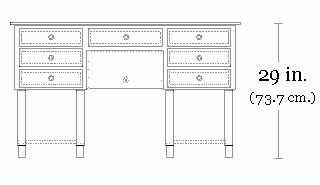
A desk or bureau is a piece of furniture with a flat table-style work surface used in a school, office, home or the like for academic, professional or domestic activities such as reading, writing, or using equipment such as a computer. Desks often have one or more drawers, compartments, or pigeonholes to store items such as office supplies and papers. Desks are usually made of wood or metal, although materials such as glass are sometimes seen.
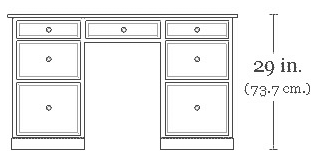
A pedestal desk or a tanker desk is usually a large, flat, free-standing desk made of a simple rectangular working surface resting on two pedestals or small cabinets of stacked drawers of one or two sizes, with plinths around the bases. Often, there is also a central large drawer above the legs and knees of the user. Sometimes, especially in the 19th century and modern examples, a "modesty panel" is placed in front, between the pedestals, to hide the legs and knees of the user from anyone else sitting or standing in front. This variation is sometimes called a "panel desk". The smaller and older pedestal desks with such a panel are sometimes called kneehole desks, they were intended for small spaces like boudoirs and were usually placed against a wall. The kneehole desks are also known as bureau tables.
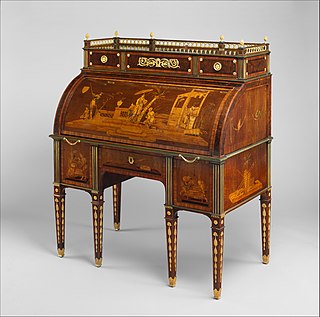
The cylinder desk is a desk that resembles a Bureau Mazarin or a writing table equipped with small stacked shelves in front of the user's main work surface, and a revolving cylinder part that comes down to hide and lock up the working papers when the desk is not in use.

A writing table has a series of drawers directly under the surface of the table, to contain writing implements, so that it may serve as a desk. Antique versions have the usual divisions for the inkwell, the blotter and the sand or powder tray in one of the drawers, and a surface covered with leather or some other material less hostile to the quill or the fountain pen than simple hard wood.

The slant-top desk, also called secretary desk, or more properly, a bureau, is a piece of writing furniture with a lid that closes at an angle and opens up as a writing surface. It can be considered related, in form, to the desk on a frame, which was a form of portable desk in earlier eras.
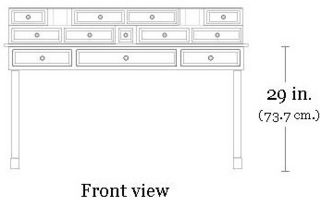
A bureau à gradin is an antique desk form resembling a writing table with, in addition, one or several tiers of small drawers and pigeonholes built on part of the desktop surface. Usually the drawers and pigeonholes directly face the user, but they can also surround three sides of the desk, as is the case for the Carlton house desk form. A small, portable version is a bonheur du jour.

Jean-Henri Riesener was a famous German ébéniste (cabinetmaker), working in Paris, whose work exemplified the early neoclassical "Louis XVI style".

A Liseuse desk is a medium-sized writing table with a small hinged panel in the middle which can spring up by the aid of a mechanism or be propped up at a desired angle to facilitate reading, or writing on its slanted surface. Many have lateral panels which swing out on both sides to give a larger desk surface.
The secretaire en portefeuille is an antique desk form which is usually mounted on rollers at the end of four jutting legs. The legs in turn support what looks like an oversize vertically mounted wooden pizza box. This is a cabinet a few inches thick, with barely enough space in it for the raised desktop surface and a few pens and sheets of paper disposed vertically. It is also called a "Billet doux".

The Bureau du Roi, also known as Louis XV's roll-top desk, is the richly ornamented royal cylinder desk which was constructed at the end of Louis XV's reign, and is now again in the Palace of Versailles.

A games table desk is an antique desk form which has a writing surface etched or veneered in the pattern of a given board game. It also provides sufficient storage space for writing implements and a separate space for storing game accessories such as counters. It is often called a "games table" or game table, which leads to confusion with pieces of furniture which are built specifically for gaming only, with no intention or provision for use as a desk.
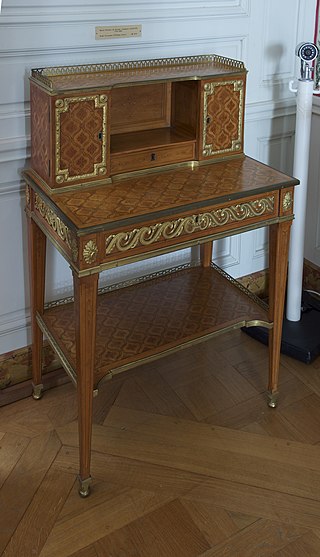
A bonheur du jour is a type of lady's writing desk. It was introduced in Paris by one of the interior decorators and purveyors of fashionable novelties called marchands-merciers about 1760, and speedily became intensely fashionable. The bonheur du jour is always very light and graceful, with a decorated back, since it often did not stand against the wall but was moved about the room ; its special characteristic is a raised back, which may form a little cabinet or a nest of drawers, or open shelves, which might be closed with a tambour, or may simply be fitted with a mirror. The top, often surrounded with a chased and gilded bronze gallery, serves for placing small ornaments. Beneath the writing surface there is usually a single drawer, often neatly fitted for toiletries or writing supplies. Early examples were raised on slender cabriole legs; under the influence of neoclassicism, examples made after about 1775 had straight, tapering legs.

Rocaille was a French style of exuberant decoration, with an abundance of curves, counter-curves, undulations and elements modeled on nature, that appeared in furniture and interior decoration during the early reign of Louis XV of France. It was a reaction against the heaviness and formality of the Louis XIV style. It began in about 1710, reached its peak in the 1730s, and came to an end in the late 1750s, replaced by Neoclassicism. It was the beginning of the French Baroque movement in furniture and design, and also marked the beginning of the Rococo movement, which spread to Italy, Bavaria and Austria by the mid-18th century.

The Louis XIV style or Louis Quatorze, also called French classicism, was the style of architecture and decorative arts intended to glorify King Louis XIV and his reign. It featured majesty, harmony and regularity. It became the official style during the reign of Louis XIV (1643–1715), imposed upon artists by the newly established Académie royale de peinture et de sculpture and the Académie royale d'architecture. It had an important influence upon the architecture of other European monarchs, from Frederick the Great of Prussia to Peter the Great of Russia. Major architects of the period included François Mansart, Jules Hardouin-Mansart, Robert de Cotte, Pierre Le Muet, Claude Perrault, and Louis Le Vau. Major monuments included the Palace of Versailles, the Grand Trianon at Versailles, and the Church of Les Invalides (1675–1691).

The furniture of the Louis XV period (1715–1774) is characterized by curved forms, lightness, comfort and asymmetry; it replaced the more formal, boxlike and massive furniture of the Louis XIV style. It employed marquetry, using inlays of exotic woods of different colors, as well as ivory and mother of pearl.

The furniture of Louis XIV was massive and lavishly covered with sculpture and ornament of gilded bronze in the earlier part of the personal rule of King Louis XIV of France (1660–1690). After about 1690, thanks in large part to the furniture designer André Charles Boulle, a more original and delicate style appeared, sometimes known as Boulle work. It was based on the use of marquetry, the inlay of pieces of ebony and other rare woods, a technique first used in Florence in the 15th century, which was refined and developed by Boulle and others working for the King. Furniture was inlaid with thin plaques of ebony, copper, mother of pearl, and exotic woods of different colors in elaborate designs.

Louis XVI furniture is characterized by elegance and neoclassicism, a return to ancient Greek and Roman models. Much of it was designed and made for Queen Marie Antoinette for the new apartments she created in the Palace of Versailles, Palace of Fontainebleau, the Tuileries Palace, and other royal residences. The finest craftsmen of the time, including Jean-Henri Riesener, Georges Jacob, Martin Carlin, and Jean-François Leleu, were engaged to design and make her furniture.
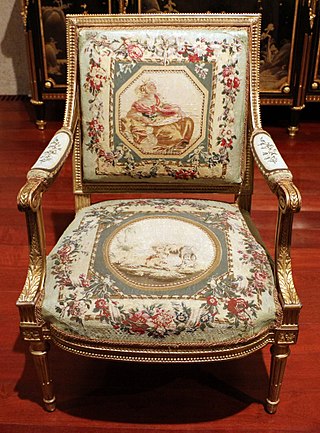
Jean-Baptiste-Claude Séne (1747-1803) was a French furniture maker in the 18th century, primarily during the reign of Louis XVI. He came from a noted family of menuisiers, or furniture craftsmen. cabinet makers. His grandfather Jean established a workshop, which was inherited by his father Claude I (1724-1792), who earned the title of a master craftsman in 1743, and made chairs and armchairs for Louis XV. Jean-Baptiste-CLaude became a master in 1769. His younger brother, Claude II, also became a master in 1769, and both made chairs for Louis XVI.

